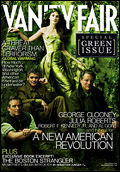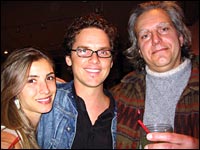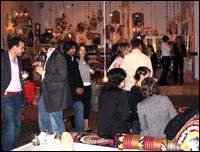Wednesday, 19 Apr 2006
New York, N.Y.
Why was last night different from all other nights on which people have gathered to party for an environmental crusade? Because it was the launch party for the first green issue of Vanity Fair — a glossy, celebrity-drenched cry to mainstream America that global warming is “a threat graver than terrorism.” About 450 people — from friends of the magazine to a cross-section of New York City’s green activists — packed the swanky second floor of event co-sponsor ABC Home, a retailer of domestic luxe. They schmoozed, strategized, and even got a rousing bit of environmental gospel from Robert F. Kennedy Jr. The sum of the evening’s message? Denial of denial is the new environmentalism. It’s OK to live well, as long as you live smart.

The guest of honor.
The badge of entry was a tiny pink peace-sign button, distributed to attendees as they were checked off the guest list. Co-hosts Paulette Cole, CEO and creative director of ABC Home, and Graydon Carter, editor in chief of Vanity Fair, circulated with smiles and handshakes. Guests in satin dresses and sharp suits snacked on raw-food treats and washed them down with organic cocktails. They kissed cheeks and traded business cards amid a pricey assortment of sustainable-sourced wood-top tables and organic-upholstered couches. “It’s the green people meet the beautiful people,” quipped Andrew Shapiro, founder and CEO of Green Order, the sustainable business consultancy that helped strategize GE’s Ecomagination initiative. Despite this arch observation, Shapiro was enjoying the union, seeing it as a “directionally correct” manifestation of environmental concern beyond a narrow niche and into America at large.
Brian Howard, managing editor of E Magazine, agreed — if from a slightly different angle. “E got a ton of negative feedback when it ran a cover featuring the Simpsons in the late 1990s,” he said. “People said, ‘These issues are serious. You can’t run a cartoon on the front of the magazine!'” Taking a sip of his cu-tini — a concoction of fresh cucumber juice, mint, agave nectar, grapefruit juice, and vodka, with a jaunty cucumber slice as garnish — Howard wondered if the visibility of environmental issues on the Vanity Fair cover might help eco-activists lighten up a little. “Perhaps we’re in the post-greenwashing stage,” he said, “and now it’s OK to be hip.”

Olga Sasplugas and Graham Hill of Treehugger, Remy Chevalier of ICInyc.
Photos: Emily Gertz.
But at least one advocate was eyeing these hip doings with a bit of good-natured reserve. Wendy Brawer, founder and director of the Green Map System, was clearly enjoying herself (and her cu-tini), chatting with friends and colleagues like Remy Chevalier of ICInyc, Graham Hill of Treehugger, and Starre Vartan, founder and editor of the green blog Eco-Chick. As she surveyed the furniture selection, she wondered if there wasn’t an inherent contradiction in the mix of materialism and environmentalism. “I hope when people walk into ABC, they’ll also realize that things they already own just need a little twist to be made new again,” she said.
Introducing speaker Kennedy, Cole referred to her inventory as “products that serve the planet, and allow consumers to vote with their dollars.” Randy Hayes agrees that economics is an inescapable part of the picture. The Rainforest Action Network founder now directs the International Forum on Globalization, a think tank developing ideas and strategies for what he calls “ecologizing” capitalism. “An event like this has utility” for moving environmentalism beyond its niche status, he said. And so does far-reaching journalism like Vanity Fair‘s: “We need the hard-hitting stories that reach outside the choir.”
Asked what he thinks has led to the rush of global-warming reporting in the glossies, Hayes had a one-word answer: “Katrina.” The storm was “an eco-spasm that hit people in the solar plexus,” he said. “Katrina’s real name is climate disruption — which will likely turn into climate chaos.” Hayes feels Katrina has “triggered people to address the critical issue of our time: saving the life-support system of the earth.”

The place to be scene.
So after all these years of environmentalists and scientists sounding the alarm and the press largely ignoring it, why is now the moment when Vanity Fair readers are ready for an issue about climate meltdown — albeit one graced with an image of Julia Roberts as an eco-sprite? “At Vanity Fair, we cover all aspects of the national conversation — and this is the subject not only of the moment, but of the decade and the century,” said Carter after the event. “It should be on the cover of every magazine right now.”
While researching his 2004 book What We’ve Lost, an indictment of the Bush administration, Carter got up to speed on the administration’s crimes against the environment, especially its “gross negligence” on global warming. “That really got me going,” he said, “and caused me to expand the magazine’s coverage of the environment and to devote an entire issue to it.”
Is this the flavor of the month? Will the memory of the cu-tini fade with the next glossy cover? Vanity Fair did earn jeers in some circles for backing away from printing the issue on recycled paper. But Carter says the magazine will continue to bolster its environmental journalism, and may put out a green issue every year.
For his part, Hayes sees the surge in green coverage as just one sign that despite the dire times, there’s reason for hope. “We used to talk about the mainstream press — now we talk about the media,” he said. “This is mass media turning back into the free press.”


